Transforming Your Outdoor Space with Creativity
Introduction – Garden Projects for Beginners
A gardener’s path is full of possibility, imagination, and the limitless splendor of nature. No matter how much or little experience you have with gardening, the temptation to create your private haven in the great outdoors is hard to resist. This detailed guide will explore do-it-yourself garden projects for beginners. Follow the steps to make your outside area a haven of beautiful flowers, verdant foliage, and peaceful retreats.
A deep connection to the land, a waltz with the changing seasons, and an ode to the cyclical nature of life are all encapsulated in gardening. When one applies their imagination and resourcefulness, even a little plot of land can be transformed into a floral masterpiece. There is a limitless amount of potential in gardening, from growing your vegetables to feed your body and soul to decorating your space with a cascade of flowers to please your senses or even making magical homes for garden fairies to play in.
In this article, we will take you on a tour of ten simple do-it-yourself garden projects for beginners that will provide garden projects for beginners with the tools they need to start their gardening journey. From terrariums to fairy gardens, raised beds to terrariums, every garden projects for beginners presents a different chance to develop beauty, encourage biodiversity, and establish a stronger bond with nature. Get your gardening tools ready because we will be digging in together!
Raised Bed Garden – Garden Projects for Beginners
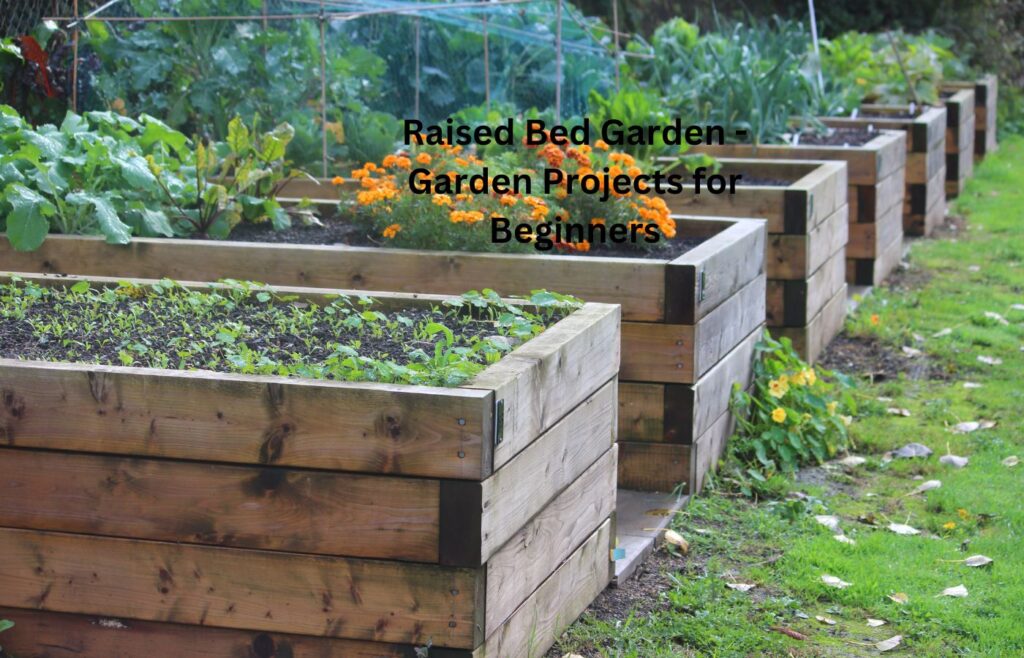
If you’re just starting gardening, a raised bed garden is a great way to get your feet wet because of all its advantages for healthy plant development. Raised beds offer an ideal setting for plants to flourish, offering better soil control, drainage, and less weed competition than regular beds on the ground.
Simple and adaptable, you all need common building supplies like lumber, bricks, or concrete blocks to build a raised bed garden. After deciding on the ideal spot with plenty of sunshine and flat terrain, you can assemble the frame according to your specifications. To improve fertility and structure, fill the raised bed with a soil combination rich in nutrients and includes organic materials like compost.
Gardeners can produce a broad variety of products in raised beds, including vegetables, herbs, flowers, and even decorative shrubs, which is one of the main advantages of this type of gardening. People with mobility issues or limited space might benefit greatly from raised beds because of the elevated shape, which makes planting, watering, and harvesting much easier.
A raised bed garden projects for beginners is an attractive and functional option for those new to gardening who want to create their little piece of heaven, whether in a cramped city garden or a sprawling backyard. With the right amount of TLC, your raised bed garden may thrive and provide a constant stream of seasonal flowers and vegetables.
Vertical Herb Garden – Garden Projects for Beginners
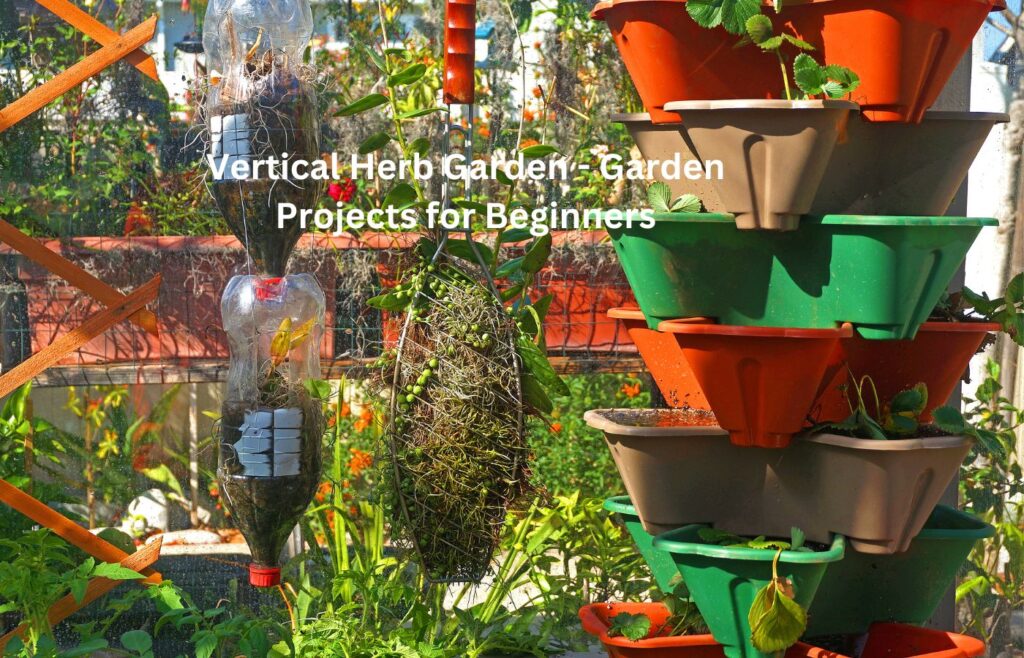
A vertical herb garden is a great option if you need more floor space but want to grow your herbs. Vertical herb gardens are a great way to make the most of vertical space; they may be grown on walls, fences, or inside, making them ideal for city dwellers, balcony gardeners, or anybody with limited outdoor space.
A vertical herb garden can be quickly and easily made with little skill and supplies. Various options include hanging planters, reused wooden pallets, wall-mounted containers, and tiered shelves. Ensure your herbs get enough sunshine by placing your vertical garden in a sunny spot.
Vertical gardens are a great way for foodies to grow herbs like thyme, basil, mint, and parsley in an eco-friendly way. Plant each herb in its pot or pocket using a potting mix that drains well to encourage healthy roots and avoid waterlogging.
Vertical herb gardens provide practical benefits and enhance the visual appeal of any indoor or outdoor space by bringing a touch of nature and greenery. Whether you want to grow herbs for cooking, making herbal remedies, or just enjoying the sight and smell of fresh foliage, a vertical herb garden can help you connect with nature and enjoy gardening, regardless of your home’s size.
DIY Compost Bin – Garden Projects for Beginners
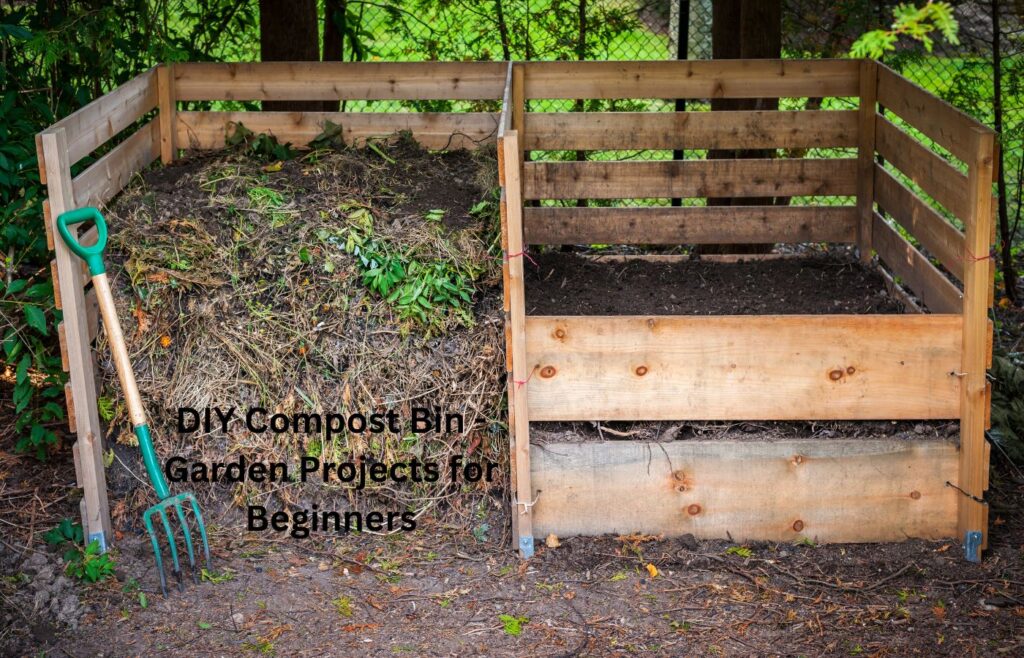
A simple and environmentally friendly approach to recycling organic waste and making soil rich in nutrients for your garden projects for beginners is to build your compost bin. If you have some basic tools and time, you can make something useful from your food scraps and yard debris that may feed your plants and keep them out of the garbage.
The best spot for a do-it-yourself compost bin is one that gets shade from the sun and has sufficient ventilation. Bins made of wire mesh, wooden pallets, recycled plastic, or garbage cans are just a few options.
Put together the selected components to form a strong framework for the bin, ensuring adequate ventilation and easy access. You can use the pallets as bins to make a three-sided enclosure out of wooden pallets, with one side left open for turning and adding compost.
Alternate layers of brown (dry leaves, straw, cardboard, etc.) and green (kitchen scraps, grass clippings, garden waste, etc.) elements make up compost. Bring in helpful microbes that speed up the decomposition process by adding a shovelful of dirt or compost.
If you want your compost pile to stay at the right moisture level and break down faster, you must water it and turn it often. Suppose you’re patient and use your do-it-yourself compost bin regularly. In that case, you may turn organic waste into nutrient-rich compost to improve the soil, stimulate plant growth, and create a more sustainable garden environment and garden projects for beginners.
Mosaic Stepping Stones – Garden Projects for Beginners
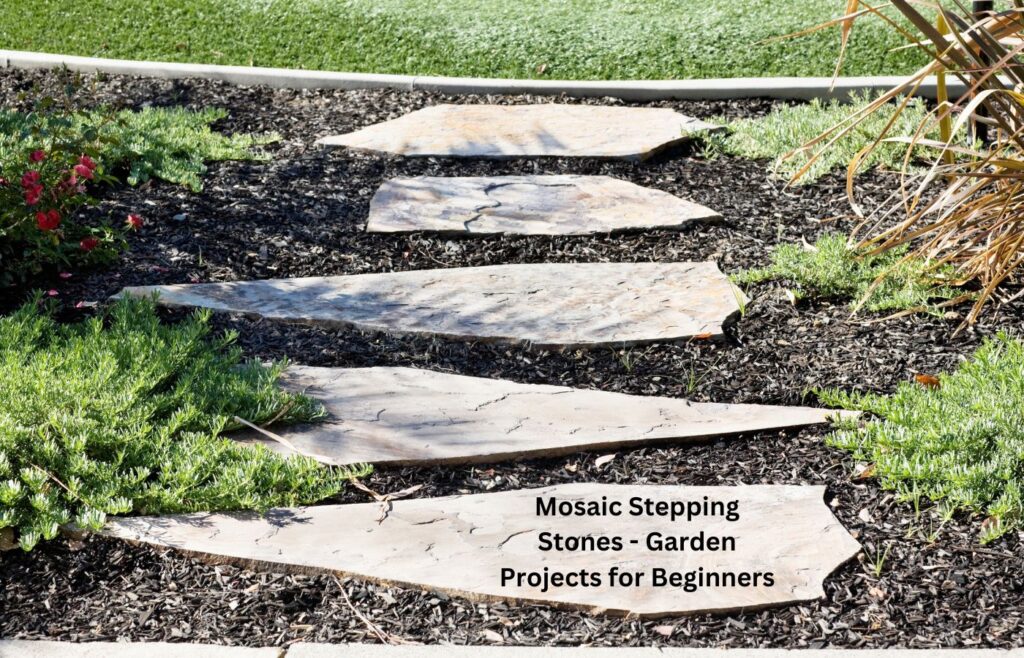
A garden path or walkway can be adorned with mosaic stepping stones for an artistic and practical touch. These ornamental stones offer a functional surface for stepping on and a chance for personalization and creative expression.
Get on some concrete mix, a mold (such as a plastic tray or cake pan), and various mosaic tiles, glass beads, or other ornamental components to make mosaic stepping stones. Following the manufacturer’s instructions, mix the concrete according to the specified thickness and pour it into the mold.
Insert the mosaic tiles or other ornamental components into the surface, arranging them according to your preference, before the concrete hardens. For a secure bond, press the tiles down onto the concrete.
Take the stepping stone out of the mold after the concrete has hardened, and let it dry entirely. You can seal or grout the surface for added longevity and protection from the elements for an extra decorative touch.
Spacing your mosaic stepping stones evenly and ensuring they are level and stable, arrange them along your garden path or walkway. Inviting guests to stroll around your garden projects for beginners to appreciate your craftsmanship, these one-of-a-kind, and customized stepping stones will enhance the aesthetic appeal of your outdoor area.
Terrariums – Garden Projects for Beginners

A terrarium is a fascinating and easy-to-care-for way to bring the natural world inside by cultivating tiny ecosystems in a glass container. Ideal for people with hectic schedules or limited gardening areas, these self-contained dwellings require no maintenance.
You’ll need a transparent glass bowl, jar, or vase with a big opening to make a terrarium. Before adding a thin layer of activated charcoal to aid in air purification and odor prevention, fill the base of the container with gravel or small stones to promote drainage.
Next, a layer of nutrient-rich, well-draining potting soil designed for houseplants should be added. Find a variety of small plants that thrive in low light and average watering conditions, like ferns, air plants, or succulents.
Space out the plants in the terrarium so they may grow and breathe easily. You can scatter rocks, driftwood, or little figurines throughout to make it look more natural and add flair.
Because root rot might occur from too much water, be careful not to overwater the terrarium. Direct sunlight might cause the terrarium to get too hot and humid, so it’s best to put it somewhere with bright, indirect sunshine instead.
When you nurture your terrarium with the right attention, it will grow into a little green haven that will bring nature into your house.
Pallet Planter – Garden Projects for Beginners

An innovative and eco-friendly method to make the most of limited gardening areas while bringing a touch of rustic beauty indoors or out is to upcycle wooden pallets into vertical planters. Gardeners of all abilities will love these multipurpose planters since they can grow everything from herbs and flowers to veggies.
To build a pallet planter, first find a solid wooden pallet that is not rotten or otherwise damaged. After giving the pallet a good scrub with a soft brush and mild detergent, sand it down to eliminate sharp edges or splinters.
The next step is determining if you’d prefer to use the pallet as-is or break it down into smaller planter boxes. When taking it apart, use a pry bar or hammer to gently peel the slats away from the pallet without damaging the wood.
To keep dirt from leaking out after you have your pallet or individual slats, line the bottom and rear with landscape fabric or a weed barrier. After filling each portion with a potting mix that drains well, plant the herbs, flowers, or veggies you choose, ensuring they have enough room to grow.
Use hooks, brackets, or chains to hang the pallet planter vertically from a strong wall or fence; be careful not to let it topple over. To keep your plants healthy and producing at their best, water them frequently and check their progress; make adjustments as needed.
If you’re creative and resourceful, you may use a pallet planter to create a beautiful and sustainable garden project for beginners in any area of your home or backyard.
DIY Bird Feeder – Garden Projects for Beginners
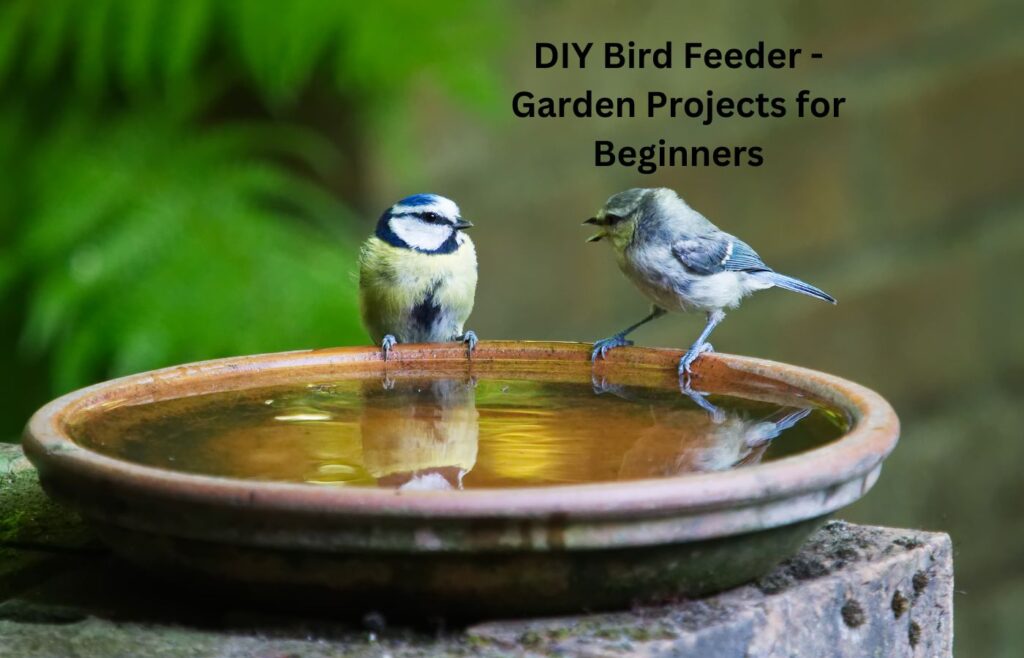
A do-it-yourself bird feeder is an easy and satisfying way to bring birds to your yard while also giving food to the animals living there. Make your eco-friendly bird feeder from common household items and repurposed materials.
An empty plastic bottle, some sticks or dowels made of wood, some string or wire, and bird seed are the basic components of a bird feeder. Please ensure the birds can get the seed by cutting or drilling holes in the plastic bottle’s sides, and provide room at the bottom for them to perch. To make perches for the birds, insert the dowels made of wood into the holes.
Then, using wire or thread, wrap it around the bottle’s neck and tie it to a garden pole, branch, or hook to make a bird feeder hanger. Put birdseed in the feeder and put it somewhere dry and easily accessible.
Place your homemade bird feeder in a shady, out-of-the-way area where birds can see it and avoid predators. Keep the feeder clean and stocked with new seeds to prevent the growth of mold and germs.
In addition to helping with conservation efforts and providing much-needed food for birds, making your bird feeder also gives you a chance to enjoy nature in your garden pojects for beginners while observing birds.
Garden Markers – Garden Projects for Beginners

To keep your garden neat and organized and look good, you need garden markers to identify the plants. Making your own is a great way to do both. These homemade markers are simple to whip up, providing limitless room for imagination.
Collect items like rocks, wooden spoons, or recycled wine corks to make your garden markers and garden projects for beginners. To make rock markers, select flat stones that are uniform in size and shape; use wooden or bamboo spoons to make spoon markers. You may make flat surfaces for wine cork labels by slicing them horizontally.
Find out what you’ll call your markers once you have all your supplies. Painting, permanent marker writing, or printing labels and applying them with waterproof glue are all viable options. If you want your outside project to last, use materials resistant to the elements.
Decorative features like painted motifs, stamped patterns, or engraved inscriptions can be added to garden markers to make them more personal. Another option is to use colors or symbols to distinguish between various types of plants.
Be sure to carefully place your garden markers throughout your garden beds so they can be seen and read from all angles. In addition to their functional purpose, these markers will give your garden a splash of color and character, making it more inviting and easier to tend to your plants and garden projects for beginners.
Hanging Basket Garden – Garden Projects for Beginners
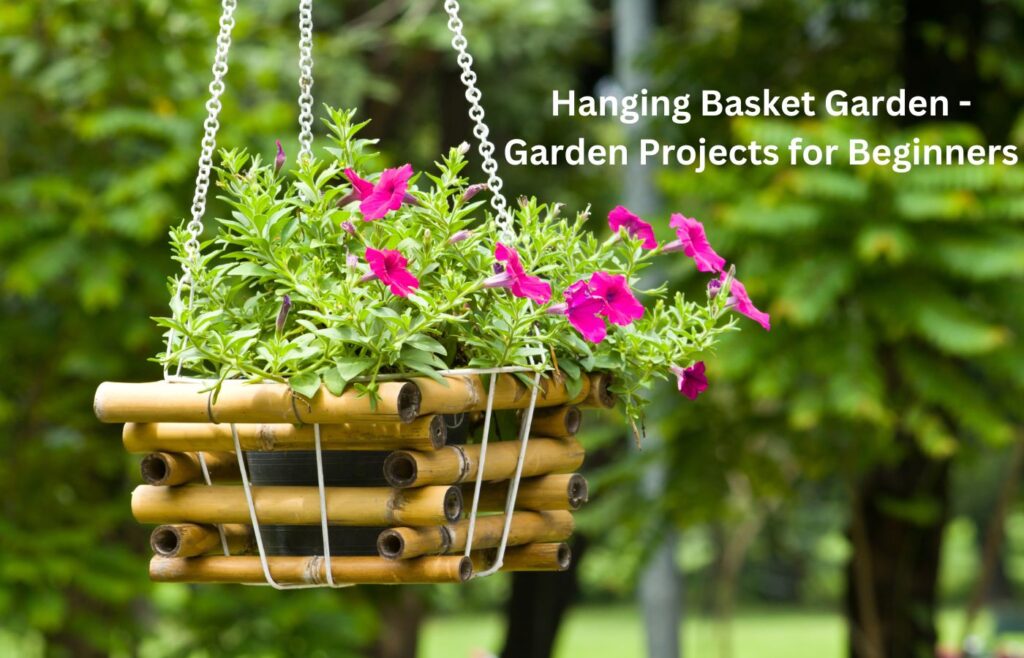
Whether you have a balcony, porch, or patio, a hanging basket garden can be a space-saving and adaptable method to bring greenery and color outdoors. If you need more floor space but want to add some greenery to your home, these hanging planters are the way to go.
Use appropriate baskets or pots with drainage holes to make a hanging basket garden. Pick herbs, trailing greenery, or flowers that do well when left hanging. When choosing plants, keep things like watering needs and the amount of sunshine in mind.
Ensure the potting soil drains well and is nutrient-rich before filling each basket. Put the taller plants in the middle of the basket and the trailing ones around the sides for a cascade look; this is how you arrange your chosen plants.
Make sure your baskets are well-anchored before filling them with soil and plants by hanging them from strong hooks, brackets, or railing mounts. Water them frequently while monitoring their moisture levels to avoid drowning or drying out your hanging basket plants.
If you give your hanging basket garden the attention it needs, it will flourish and bring life and beauty to your outside area. A hanging basket garden provides limitless opportunities for creativity and enjoyment, whether creating a verdant flower display, producing culinary herbs, or just taking in the beauty of trailing vines and vibrant blooms and garden projects for beginners.
Fairy Garden – Garden Projects for Beginners
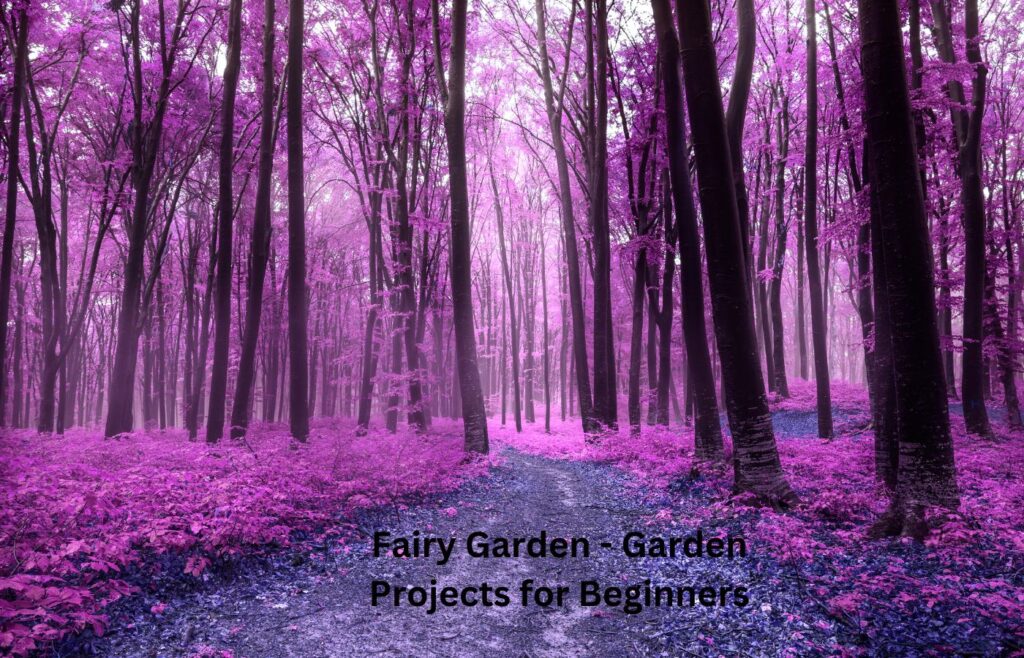
A fairy garden is a charming and whimsical little environment that invites wonder and creativity into your outdoor area. Beautifully crafted to transport visitors of all ages to a world straight out of a fairy tale, these gardens will surely be a hit with kids and grown-ups alike.
Pick a spot in your garden or an appropriate container to start your fairy garden. Pick an idea for your fairy garden, such as a fairy village, a forest glen, or a hidden hideaway in the flowers.
Get all the components for your fairy garden, including tiny plants, furnishings, figurines, stones, and more. Succulents, dwarf ferns, and little flowers are container-loving plants with a compact or petite growth habit.
Put the finishing touches on the fairy tale scene by arranging the selected items in the container or garden space, making walkways, seating spots, and other features. Add fanciful elements like miniature bridges, fairy houses, and accessories to finish the picture.
Ensure that your fairy garden is easily accessible for maintenance and enjoyment by placing it in a shaded place that receives partial sunlight. Be careful not to soak the soil or water your fairy garden too much when you water it frequently.
If you put your creative juices to good use, you may transform your ordinary garden into a fantastical paradise where fairies run amok, flowers blossom, and wishes come true. Whether you’re making a magical garden for kids to play in or just want to relax and enjoy nature, a fairy garden will surely be a garden projects for beginners.
Conclusion – Garden Projects for Beginners
Last but not least, there is no limit to the room for imagination, sustainability, and communion with nature in do-it-yourself garden projects for beginners. No matter your level of gardening expertise, these garden projects for beginners will provide you with the tools you need to turn your outside area into a lush haven of serenity and beauty.
From mosaic stepping stones to terrariums, raised bed gardens, vertical herb gardens, and more, every garden projects for beginners offers a one-of-a-kind platform for creativity and discovery. You may positively impact the environment and make useful and attractive garden projects for beginners and garden accessories by adhering to reusing, recycling, and repurposing concepts.
Tending a garden may be a calming and therapeutic experience, bringing you closer to nature and providing moments of delight and fulfillment. Immerse yourself in a timeless cycle of development, rebirth, and abundance as you nurture your plants, nourish your creativity, and watch your garden bloom.
So, whether you’re gathering veggies for a homemade dinner, appreciating the splendor of blossoming flowers, or just spending time in your garden with birds and butterflies, remember that you are part of a larger community of people who share your passion for nature and want to see the planet made more beautiful and harmonious.
How much time do these projects take?
Most projects can be completed in a day or over a weekend, making them perfect for beginners with busy schedules.
Do I need prior gardening experience?
No prior experience is necessary! These projects are designed for beginners and include step-by-step instructions.
Are these projects suitable for small spaces?
Yes, many of the projects, such as vertical gardens and container gardening, are ideal for small spaces like balconies or patios.
Can I customize these projects to fit my style?
Absolutely! These projects are highly customizable, allowing you to express your creativity and personalize your outdoor space.
Will these projects attract wildlife to my garden?
Yes, projects like bird feeders and hanging baskets can attract birds and butterflies, enhancing the biodiversity of your garden.
Are these projects environmentally friendly?
Many of the projects promote sustainability through practices like composting and upcycling materials.
How can I maintain these projects?
Maintenance requirements vary but generally involve regular watering, pruning, and occasional soil amendment.
Can I involve my family in these projects?
Yes, these projects are family-friendly and can be enjoyable activities for all ages to participate in together.
Will these projects increase the value of my home?
While they may not directly increase property value, they can enhance curb appeal and create a more inviting outdoor living space.
The article “10 Easy DIY Garden Projects for Beginners: Transforming Your Outdoor Space with Creativity” is written by HomeGardenIdeas.com. Our team of passionate writers and experts shares tips and inspiration on gardening, home improvement, and design to help you create your dream space.
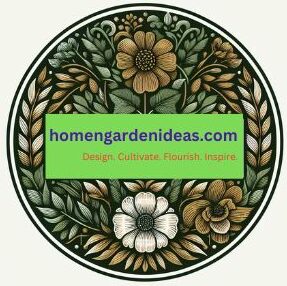
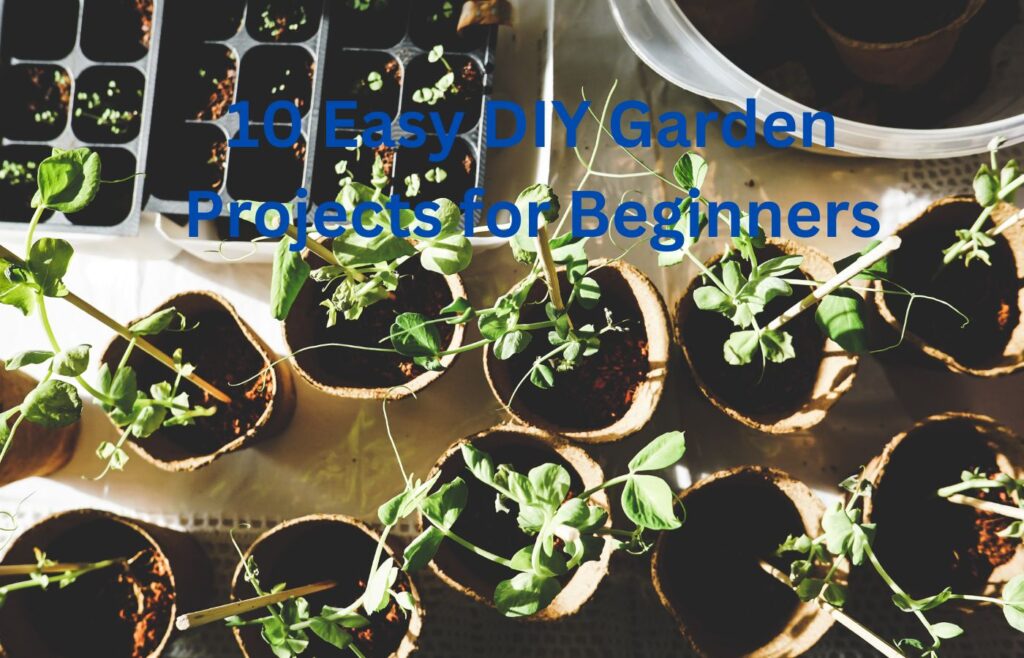
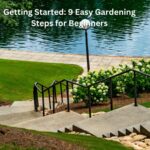

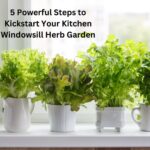
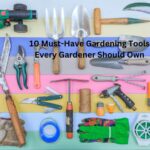


loved the post very informative, thanks for sharing